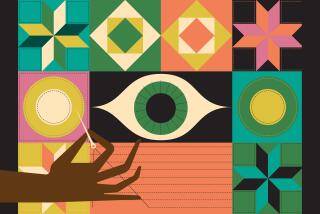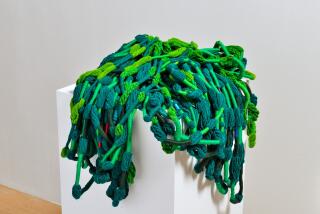WEAVING HAVOC
A war is raging within Baker Rug Gallery, a small shop just north of Wilshire Boulevard and La Brea Avenue in the heart of the Miracle Mile business district. The 26-year-old proprietor, Khalid Yagobbi, who was born in Mazar-i-Sharif in northern Afghanistan, stands silently by while a longtime customer studies a woven scene that includes two legless men, one wearing the rolled hat of the Afghan moujahedeen, the other wearing a traditional Pushtun turban, their limbs blown off by land mines, blood flowing copiously.
More blood streams from the severed limb of a woman seated near the men, her veil pulled away from her distraught face. The infant beside her reaches its tiny legs and arms skyward, a victim of one of the four helicopters buzzing overhead or the tank rolling across the border of the long-suffering nation mapped in rough outline against a crimson background.
Suddenly the distant carnage in Afghanistan is alive and close enough to touch in this 2-by-4-foot tableau in wool, colored by bright vegetable dyes. Yagobbi’s customer, film producer Daniel Ostroff, buys the rug. “To rescue it,” he says quietly.
Afghan tribal weavers began to incorporate weaponry and scenes of armed conflict into so-called “war rugs” after Soviet armies invaded the country in 1979. Prized by collectors and bought and sold on Ebay, the Soviet-era rugs portray battle scenes as vivid and violent as any nightly news footage, replete with AK-47 rifles, rocket-propelled grenades, T-54 tanks, MIGs and Hind M-24 attack helicopters. Yagobbi’s street-level shop in the Art Deco office building is one of a handful of destinations around town that, in addition to their usual supply of traditional Oriental and Afghan tribal weavings, have gained a reputation among cognoscenti for their stock of war rugs.
But lately, Yagobbi has been handling rugs that depict equally vivid scenes of U.S. troops, American military hardware, even commemorations of the Sept. 11, 2001, terrorist attacks--scenes that are attracting the attention of American textile and applied-arts collectors such as Ostroff. He has been acquiring war rugs since he came across a large one displaying a frantic profusion of Soviet-era firepower at the Rose Bowl Swap Meet more than a decade ago.
One rug in his collection, made in 1989, depicts a convoy of tanks and troop carriers, mapping the route north from Afghanistan into what then was the Soviet Union, celebrating the invaders’ final withdrawal. Woven into the lower right-hand corner of another rug is a bouquet of pink opium poppies, one of the country’s primary crops. Many feel poppies played a subtle but significant role in the Soviets’ defeat because of the addictive effects of opium on Soviet soldiers. “I like the rugs that tell a story,” Ostroff says.
But the stories are changing. A recent import displayed on a back wall of Yagobbi’s shop at 680 S. La Brea Ave. has an odd bullet-patterned border and the kind of brilliant colors Martha Stewart might recommend to brighten up a room. Closer inspection reveals an American M-1 Abrams tank beneath a map of Afghanistan and a pair of large M-16 assault rifles flanking a formation of F-16 fighter jets flying over a rugged landscape labeled “Tora Bora.” The rug’s crudely depicted mountains are punctuated by irregular black holes representing the cave hideouts of Al Qaeda and Taliban forces, against which the United States launched Operation Anaconda in March 2002. The rug’s anonymous weaver commemorated the event in natural dyes of red, blue, ivory and dusty brown.
Ali Shah Azizi apologizes for the dearth of war rugs in his shop, Rugs and Art at 412 N. Robertson Blvd., which has supplied Afghan textiles and Asian art objects to collectors for 15 years. “I sold my last [one] last week,” he says. “I have a new shipment coming in soon. Yes, the new ones with American themes. Collectors are asking me for them all the time.”
The Soviet-era rugs are more highly valued both for their superior quality and for their rarity, Azizi says. “Collectors know that these are handmade things. The weavers are not making any more of those. But when they put the date on these new rugs--’Year 2002’--it looks a little too commercial.”
The highest quality rugs are by Belouchi, Turkmen and other practiced tribal weavers, most of whom are women and children. Rugs of cruder design and quality come from refugee camps in the border regions of Pakistan or Iran, where the displaced learn the craft to eke out a living. According to Azizi--a fourth-generation rug dealer--the buyers making the rounds in the countryside purchase the entire output of a Pakistani camp or an Afghan village, no matter what designs are produced. The rugs are shipped in bulk to distribution centers in New York, London and Hamburg, Germany. Azizi buys his rugs from New York and Los Angeles wholesalers.
Yagobbi, who buys his stock directly from wholesalers in Kabul, agrees with textile experts that the war rugs are produced by people who have witnessed the things they depict. Details in the images of weapons--green bullets in the AK-47 rifle clips with a single red tracer bullet among them, for example--are too finely observed to be merely generic. And the intention appears to be more than simply the creation of souvenirs for soldiers or tourists.
“Their homes were invaded,” Yagobbi says, “and they are saying something about that.”
“In its purest form the war rug is more than a trinket made for tourists,” wrote textile expert J. Barry O’Connell Jr. in a recent issue of the Oriental Rug Review, an online publication (www.rugreview.com). “The true war rug is a cry of expression from those who have no other voice. ‘Will anyone listen? Will anyone care?’ ”
The newest designs appear to hail the presence of U.S. troops, and many weavers call the designs “America Strikes Back.” The most startling examples along this theme are offered by New Hampshire dealer Ron O’Callaghan, who conducts his trade from the rugreview.com Web site, which also contains authoritative research on war rugs.
For prices ranging from $225 to $800, he sells rugs portraying the Sept. 11, 2001, terrorist attacks on the World Trade Center. U.S. and Afghanistan flags joined by a dove of peace often adorn these rugs, and some include the inscription, “Root out terrorism with the help of America and Britain.” The apparent intention of the weavers--often women and children who suffered under the Taliban rule--is to celebrate the entry of Afghanistan’s liberators into the fight against their oppressors. Yet the central image on these 2-by-3-foot rugs of hijacked airplanes crashing into the twin towers is shocking--and about as far from tasteful household decoration as any rug can get.
O’Callaghan, whose clients include doctors, lawyers and other professionals, says he must delicately determine whether his buyers “want the rug with people jumping out of the buildings, or without.”
More to Read
The biggest entertainment stories
Get our big stories about Hollywood, film, television, music, arts, culture and more right in your inbox as soon as they publish.
You may occasionally receive promotional content from the Los Angeles Times.










